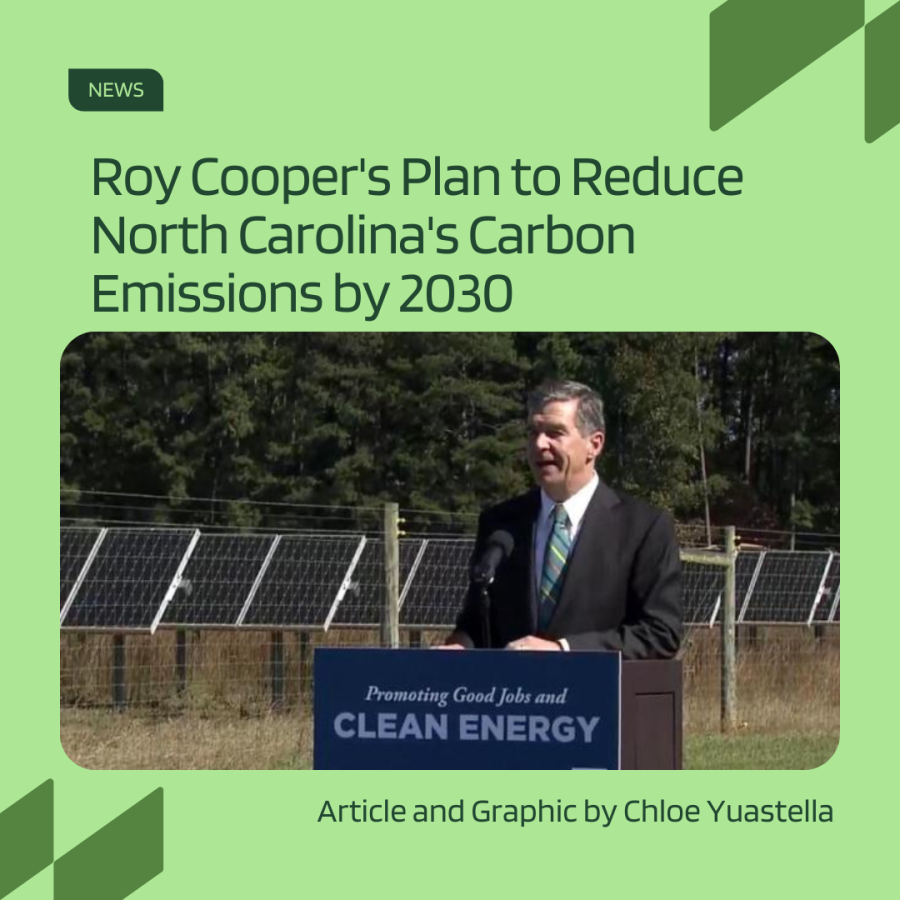Roy Cooper’s Plan to Reduce North Carolina’s Carbon Emissions
North Carolina is currently making strides to reduce carbon emissions and work towards a greener future.
Governor Roy Cooper recently announced a report that will set new goals to reduce greenhouse gas emissions in the state, the Deep Decarbonization Pathways Analysis. This is seen as a positive step forward by environmental groups, as North Carolina has been one of the largest contributors to carbon emissions in the United States.
The report will work to strengthen Cooper’s executive order that went into effect on Jan. 7, 2022. The order requires that all state agencies and departments—including transportation, energy and natural and economic resources—create strategies to reduce carbon emissions. It calls for the state to reduce emissions by expanding renewable energy like wind and solar power and transitioning to electric vehicles.
Investment in infrastructure, such as car charging stations and renewable energy projects, is being implemented to make the necessary changes more accessible. The order also creates a state climate change Interagency Council that will develop a plan to reduce carbon emissions by 40 percent by the year 2030, compared to the emissions from 2005.
In addition to the governor’s actions, the North Carolina Department of Environmental Quality has proposed a Cleaner Air for North Carolina Rule, which would require the state’s 350 largest emitters of pollutants to reduce their emissions.
This executive order is the first of its kind in the Southeast and is expected to have a significant impact on the reduction of air pollution in the state. It also sets an example for other states to follow, as many states have yet to put forward concrete plans to reduce their emissions.
The reduction in emissions is anticipated to have a positive effect on the state’s economy as well, with the investment in renewable energy expected to create thousands of jobs. It is also expected to reduce energy costs for residents and businesses, as renewable energy sources become more cost-effective.
“I think this is really important because it shows how easy it can be for the government to intervene to reduce our emissions, as long as the problem is properly addressed and researched,” says Regan Lloyd, the president of Enloe’s Student Sustainability Alliance. “Many politicians don’t even believe that climate change is a problem so this is a big step forward.”
While the executive order affects only state agencies, Lloyd adds that personal changes can also make communities greener.
“Even stuff like turning off the lights when you leave a room and turning off your water when you brush your teeth can help at a local level,” says Lloyd.
The governor’s executive order and the proposed rule are both major steps toward reducing emissions in North Carolina. The Pathways Analysis will help North Carolina reach its goal of reducing emissions and creating a healthier future for its citizens.
“The executive order is still in progress right now, so I’m excited to see the progress that we can make by 2030,” says Lloyd. “By the next election, a lot of [high school students] will be voting for the first time and these are policies that we need to be thinking about when casting our votes.”
Works Cited
“Governor Cooper Releases New Report Outlining Strategies to Strengthen North Carolina’s Clean Energy Economy and Achieve Climate Goals” NC.gov https://governor.nc.gov/news/press-releases/2023/02/02/governor-cooper-releases-new-report-outlining-strategies-strengthen-north-carolinas-clean-energy
Your donation will support the student journalists of Enloe Magnet High School, allowing us to cover our annual website costs. We are extremely grateful for any contribution, big or small!

(She/her)
Chloe is excited to be back for her second year in the Eagle's Eye! She loves reading autobiographies, drinking iced lattes, and listening...










